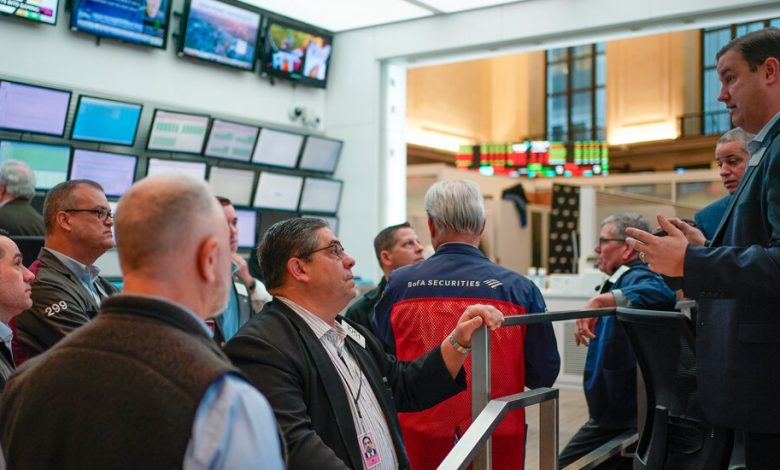N.Y.S.E. Glitch Leads to Wild Swings in Share Prices

The New York Stock Exchange on Tuesday had a glitch that led to wild price swings that affected over 250 stocks, including shares of large companies like Wells Fargo, Verizon and Nike.
Shares of Nike fell more than 12 percent immediately after trading began at 9:30 a.m. in New York. In less than a second, Verizon swung between a loss of over 17 percent and a gain of nearly 13 percent, while Wells Fargo plummeted more than 15 percent.
The moves, which added or wiped out billions of dollars of market value, led the exchange to halt trading in just over 80 different shares. Stock exchanges have built-in “circuit breakers” that automatically pause trading if a stock price suddenly swings by a large amount.
Once trading resumed, the companies’ share prices moved more or less in line with a typical trading day. Shares of Nike, Verizon and Wells Fargo, for example, had gained or lost less than 2 percent by the end of trading on Tuesday.
The explanation for the turmoil, the exchange said, was a malfunction in its system at a crucial time for the financial markets. Typically, the N.Y.S.E. holds an opening auction at the start of trading day, collecting orders from buyers and sellers to set the opening price of individual stocks. The exchange said that for some stocks “opening auctions did not occur,” resulting in the market mayhem.
Our Coverage of the Investment World
The decline of the stock and bond markets this year has been painful, and it remains difficult to predict what is in store for the future.
- 2023 Predictions: There are plenty of forecasts coming for where the S&P 500 will be at the end of the year. Should you be paying attention to them?
- May I Speak to a Human?: Younger investors who are navigating market volatility and trying to save for retirement are finding that digital investment platforms lack the personal touch.
- Tips for Investors: For people who don’t have the luxury of a long horizon, money market funds and certificates of deposits can offer attractive yields.
- Weathering the Storm: The rout in the stock and bond markets has been especially rough on people paying for college, retirement or a new home. Here is some advice.
The whipsaw trading meant some investors will have paid much more to buy shares than the prevailing market price, while others paid much less. Some investors said their trades simply weren’t executed, with significantly reduced trading volumes. Traders said they expected much of the activity to be reversed.
“Somebody is having an unhappy day,” said Edward Monrad, head of market structure at Optiver, a so-called market maker, which is a type of business expected to buy and sell shares to facilitate trading. “Those trades will most likely get busted, which means people are sitting on trades that they are uncertain exist.”
By the afternoon, the N.Y.S.E. said its member firms could flag erroneous trades or request compensation for losses arising from Tuesday’s events, in accordance with its rules. The exchange later said some trades in over 250 stocks would automatically be declared “null and void.”
Some investors had earlier raised concerns about the extent of the price moves, before circuit breakers were set off. Exchanges like the N.Y.S.E. use what are known as “limit up, limit down” triggers to stop trading in a stock if its price moves too much, too quickly.
At the open, this is typically set at 5 percent or 10 percent above and below the stock’s opening price. These triggers are designed to protect investors from sharp moves, allowing markets a moment to pause and reset prices before they spiral out of control.
Trade data shows, however, that some transactions were executed outside these ranges.
The tobacco company Altria ended Monday at a price of $44.81. It opened on Tuesday up over 15 percent at $51.57, which appeared to set the stock’s lower trading limit 5 percent lower at $48.99. Yet within milliseconds trades were executed around $47, $38, $42, $45 and $44 before the price jumped back to $48.99, according to reported trade data.
Some of these trades were among those the N.Y.S.E. said it would reverse.
Reversing trades, though, could create further problems for investors who were unsure if they had bought or sold stock, or not. This could also knock on to trades conducted on other exchanges affected by the volatility on the N.Y.S.E.



